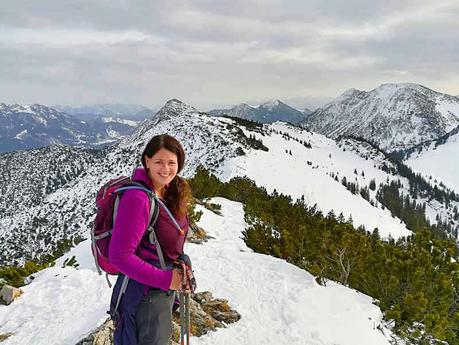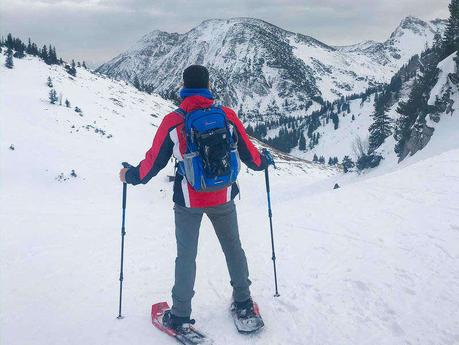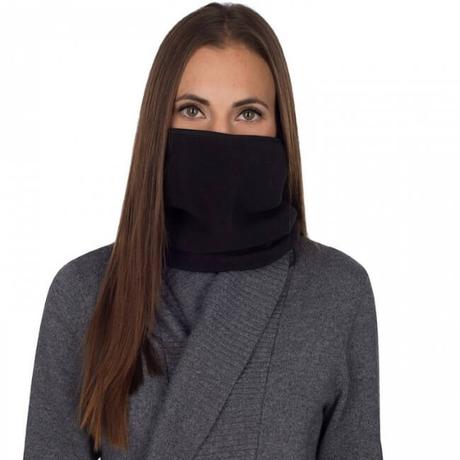This post may include affiliate links, including Amazon Associate links. I may earn money if you click on one at no extra cost to you.
Your winter hiking gear should include layers, moisture-wicking fabric and thermal gloves to stay warm.

Many hikers think that winter hiking gear has to be extensive and expensive. But it doesn't have to be. You just need a few key pieces and you're now set to hike in winter or in cold weather in warmth.
Read on to see what extra gear and clothing you need to stay warm. And the number one thing you need to stay safe which you can buy for less than $10!
You'll also find out which of your summer hiking gear you can use in winter saving you $$$ on new hiking gear.
Related Reading: The Best Underwear for Hiking.
The 2 Most Important Things To Know About Winter Hiking Clothing


1)You might think that it should be big and bulky but thanks to technological advances in clothing, winter hiking clothing can be surprisingly sleek. And that's where the first tip comes in.
Layering for Winter Hiking
Layering is so important because even when the temperature is cool, you may work up a sweat. And if you do, you want the option to be able to take a layer off. It's much better to wear 3 light layers than 1 or 2 heavy ones.
Or maybe you need fewer layers on the way up a mountain, but more on the way down when you're not sweating as much. Or the sun drops down behind the mountain. If you're worried about freezing, it may be tempting to put on the biggest fluffiest sweater you can find, but layering will not only keep you warmer, it's also more comfortable and you won't feel like the Michelin man.
When I'm winter hiking I'll frequently take layers on and off as I work up a sweat, or if I go from hiking the shade to the sun.
Choose Moisture Wicking Fabric Hiking Gear
Don't even think about wearing cotton when winter hiking. When you sweat, it gets wet and you'll get cold. Instead, look for moisture-wicking fabric. When you sweat, it wicks the sweat away from you, keeping you warmer.
You can buy man-made moisture-wicking fabrics made of polyester, but my favourite is Merino wool.
Not only is it warm, moisture-wicking, incredibly soft, but it's also natural and smell resistant. As a test, I once bought a Merino wool shirt that promised you could wear it 10 times without it smelling. I had my doubts but tried it on a multi-day hike and wore it five times before washing it.
Surprisingly, it didn't smell, but after wearing it for five days straight, I thought it was time to hit the washing machine.
When winter hiking my base layer is always Merino wool.
This winter hiking gear list assumes that you already own summer hiking gear. That way, you can save $$ by reusing some of your gear by layering it.
If you don't have summer hiking gear, check out my Day Hiking Packing List here.
Recommended Winter Hiking Gear
Note: I've just listed women's winter hiking gear for consistency, but men can find something similar. The same information applies.
Winter Hiking Clothing
Choose Thermal Underwear for Your Base Layer
Your first layer is your thermal underwear. You can choose Merino wool which is more expensive but feels SO good on your skin and will last for years, or a synthetic version, which is cheaper, but not as warm or soft.
If you go for the Merino wool option, check out the two on the left by Icebreaker. Icebreaker is one of my favourite brands for performance clothing and it lasts for years.
If you're on a budget, then the thermals on the right are a good choice. They're fleece lined so that they're extra soft and you get two in one package for a real bargain!
Related Reading: The Best Hiking Underwear.Midlayer Clothing for Winter
Outer Layer Jacket for Winter
Related Reading: The Best Jackets for Hiking.
Winter Hiking Pants
I have three types of winter hiking pants.
1) my regular summer hiking pants that I wear with my thermal underwear underneath. This is enough on mild winter days and when it's not snowing heavily. However, these are not waterproof, or even water-resistant so they're only suited for sunny mild winter days.
2) I also have hardshell waterproof pants. I mainly use these for skiing or when II'm likely to encounter deep snow when snowshoeing or if it's snowing heavily outside. Because, these are thicker, it's important to look for ones that are breathable. That's why I like these North Face ones on the right. I usually just wear my thermal underwear underneath and it keeps me warm. Look for pants that are waterproof and insulated.
3) I also have softshell ones, that are lined with fleece, similar to these Eddie Bauer polar fleece-lined pants. They're a middle option to the two above. They're not 100% waterproof, but they move easier than hard-shelled waterproof pants and they'd be more comfortable for longer hikes or snowshoes.
Winter Hiking Gear Accessories
Related Reading: The Best Hiking Socks.
Related Reading: The Best Gaiters for Hiking.
Winter Hiking Gear To Stop You From Slipping
CAMP Snowline Chainsen ProI love these for traction and have tried several different kinds but have found Snowline to be the best. They actually stay on your feet unlike some other brands or models made with velcro, and they're lightweight and don't take up much space. I use them at some point on almost every winter hike that I do - especially when going down.
It's easy to sip when winter hiking and these help you from falling and keep you safe.
Collapsible Hiking Poles.
When looking for hiking poles, I look for ones I can use in both winter and summer. The only difference for winter is you want the ones that have rubber tips so that you don't lose them in the snow. You also want hiking poles that are collapsible so that you can easily carry them on your backpack when you're not using them. That's why I like these ones.
Hiking Boots and Waterproof Spray for Winter Hiking
In Case of Emergency When Winter Hiking
Emergency Thermal Blanket
This is the #1 item that I think should be in every hiker's backpack ALL the time, but especially when winter hiking.
It's made from weatherproof foil and retains/ deflects 90% of your heat when in use. If you find yourself unexpectedly having to spend the night due to getting lost or a sprained ankle and you can't walk any further, this could help save your life!
It's small, lightweight and costs less than $8. I always carry one with me, whether hiking in winter or summer.

